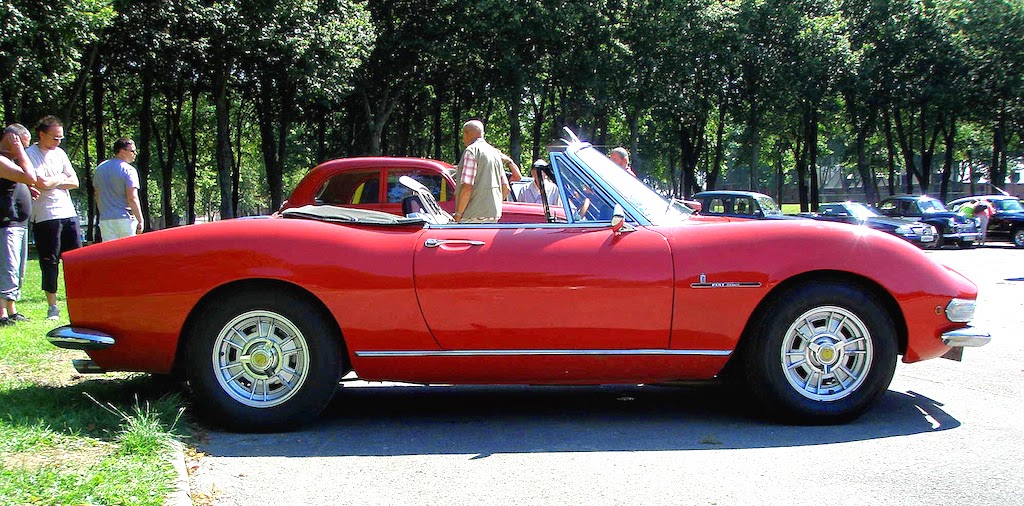The Fiat Dino was introduced at the Turin Motor Show in 1966 alongside the Dino Berlinetta GT, later to become the Ferrari Dino 246. Powered by a shared four camshaft, two litre, V6 engine, both cars benefited from a racing pedigree that went back to Ferrari's Dino 166P sports-racing unit and their 246 Grand Prix engine. However, when Ferrari decided to race in Formula 2 with its new V6 engine designed by Enzo Ferrari's son Dino, the company had a problem. Under homologation rules, they were required to build enough cars to satisy the rules for racing. Ferrari could not build enough cars to homologate the Dino so a deal was struck with Fiat for a joint venture and the Dino was born.
The Dino model was built as either a Bertone designed coupé or a sleek spider from Pininfarina. However, it is the spiders, both in 2.0 and 2.4 Litre guise, that have become most sought after amongst collectors. In the words of Sports Car Market: "The Spider is one of the prettiest designs to emerge from Pininfarina's studio in the 1960s…. and even accelerating in top gear from low revs, there's a seamless delivery of power." A mere 1,133 spiders were originally built, but far fewer are left in existence today. (silverstoneauctions.com)
The more common 2.0 cars were assembled by FIAT, whereas the 2.4 cars were assembled by Ferrari at Maranello alongside the 246s. (wikipedia)
The Dino model was built as either a Bertone designed coupé or a sleek spider from Pininfarina. However, it is the spiders, both in 2.0 and 2.4 Litre guise, that have become most sought after amongst collectors. In the words of Sports Car Market: "The Spider is one of the prettiest designs to emerge from Pininfarina's studio in the 1960s…. and even accelerating in top gear from low revs, there's a seamless delivery of power." A mere 1,133 spiders were originally built, but far fewer are left in existence today. (silverstoneauctions.com)
The more common 2.0 cars were assembled by FIAT, whereas the 2.4 cars were assembled by Ferrari at Maranello alongside the 246s. (wikipedia)
Fiat Dino Spider (1966-69)
The car was first offered with a 2.0-litre, 160 PS (118 kW; 158 hp) V6, with a 5-speed manual transmission. The same 2.0L engine was used in Ferrari Dino 206 GT (see photos below), produced during the same period. It was the first car to have electronic ignition as standard, ran in Le Mans and many of the 'Ferrari' and 'FIAT' parts are interchangeable. (wikipedia)
Dino 206 GT
Dino was a marque for mid-engined, rear-drive sports cars produced by Ferrari from 1968 to 1976. Used for models with engines with fewer than 12 cylinders, it was an attempt by the company to offer a relatively low-cost sports car. The Ferrari name remained reserved for its premium V-12 and flat 12 models until 1976, when "Dino" was retired in favour of full Ferrari branding. It shared the same 2.0L V6 engine as the Fiat Dino. Based on the Ferrari Dino Berlinetta Speciale Concept which made its debut one year earlier at the 1965 Paris Motor Show.
Fiat Dino Spider 2400 (1969-73)
The engine was later enlarged to a 2.4-liter, 180 PS (132 kW; 178 hp) unit in 1969. the 2.4 cars were as much 'Ferrari" as the 246s (see photos below), especially the 2.4 Spiders, of which only 424 were made. These cars were designed by Pininfarina and built using the same engines and assembled by the same Ferrari engineers on the same Ferrari production lines as the 246s, albeit significantly rarer. In this respect, 'FIAT' Dino and 'Ferrari' Dino was simply early marketing driven 'badge engineering'. (wikipedia)
Dino 246 GT
The Dino 206 GT remained in production unchanged through 1968 and into 1969, until it was phased out in favor of the Dino 246 GT. Otherwise the same car as the 206, the name change indicates the 246 used a new 2.4-liter version of the V6 engine. (carstyling.ru)
(Photos from classiccarsmagazine.co.uk, stelvio.dk, bonhams.com,
autowp.ru, flickr.com, larevueautomobile.com & wsupercars.com)


.png)
.png)
.png)
.png)
.png)
.png)
.png)
.png)
.png)

































































































































